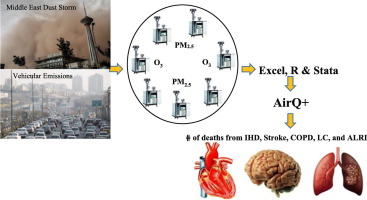Environment International ( IF 10.3 ) Pub Date : 2018-02-22 , DOI: 10.1016/j.envint.2018.02.026 Sasan Faridi 1 , Mansour Shamsipour 2 , Michal Krzyzanowski 3 , Nino Künzli 4 , Heresh Amini 4 , Faramarz Azimi 5 , Mazen Malkawi 6 , Fatemeh Momeniha 7 , Akbar Gholampour 8 , Mohammad Sadegh Hassanvand 1 , Kazem Naddafi 1

|
The main objectives of this study were (1) investigation of the temporal variations of ambient fine particulate matter (PM2.5) and ground level ozone (O3) concentrations in Tehran megacity, the capital and most populous city in Iran, over a 10-year period from 2006 to 2015, and (2) estimation of their long-term health effects including all-cause and cause-specific mortality. For the first goal, the data of PM2.5 and O3 concentrations, measured at 21 regulatory monitoring network stations in Tehran, were obtained and the temporal trends were investigated. The health impact assessment of PM2.5 and O3 was performed using the World Health Organization (WHO) AirQ+ software updated in 2016 by WHO European Centre for Environment and Health. Local baseline incidences in Tehran level were used to better reveal the health effects associated with PM2.5 and O3. Our study showed that over 2006–2015, annual mean concentrations of PM2.5 and O3 varied from 24.7 to 38.8 μg m−3 and 35.4 to 76.0 μg m−3, respectively, and were significantly declining in the recent 6 years (2010–2015) for PM2.5 and 8 years (2008–2015) for O3. However, Tehran citizens were exposed to concentrations of annual PM2.5 exceeding the WHO air quality guideline (WHO AQG) (10 μg m−3), U.S. EPA and Iranian standard levels (12 μg m−3) during entire study period. We estimated that long-term exposure to ambient PM2.5 contributed to between 24.5% and 36.2% of mortality from cerebrovascular disease (stroke), 19.8% and 24.1% from ischemic heart disease (IHD), 13.6% and 19.2% from lung cancer (LC), 10.7% and 15.3% from chronic obstructive pulmonary disease (COPD), 15.0% and 25.2% from acute lower respiratory infection (ALRI), and 7.6% and 11.3% from all-cause annual mortality in the time period. We further estimated that deaths from IHD accounted for most of mortality attributable to long-term exposure to PM2.5. The years of life lost (YLL) attributable to PM2.5 was estimated to vary from 67,970 to 106,706 during the study period. In addition, long-term exposure to O3 was estimated to be responsible for 0.9% to 2.3% of mortality from respiratory diseases. Overall, long-term exposure to ambient PM2.5 and O3 contributed substantially to mortality in Tehran megacity. Air pollution is a modifiable risk factor. Appropriate sustainable control policies are recommended to protect public health.
中文翻译:

2006-2015 年伊朗德黑兰 PM2.5 和 O3 的长期趋势和健康影响
本研究的主要目的是 (1) 调查伊朗首都和人口最多的城市德黑兰特大城市环境细颗粒物 (PM 2.5 ) 和地面臭氧 (O 3 ) 浓度的时间变化,超过 10- 2006 年至 2015 年期间,以及 (2) 估计其长期健康影响,包括全因死亡率和特定原因死亡率。对于第一个目标,获得了在德黑兰 21 个监管监测网络站测量的 PM 2.5和 O 3浓度数据,并研究了时间趋势。PM 2.5和O 3的健康影响评估使用世界卫生组织欧洲环境与健康中心于 2016 年更新的世界卫生组织 (WHO) AirQ+ 软件进行。德黑兰水平的当地基线发病率被用来更好地揭示与 PM 2.5和 O 3相关的健康影响。我们的研究表明,2006-2015 年间,PM 2.5和 O 3的年平均浓度分别从 24.7 到 38.8 μg m -3和 35.4 到 76.0 μg m -3不等,并且在最近 6 年(2010- 2015) 用于 PM 2.5和 8 年 (2008-2015) 用于 O 3。然而,德黑兰公民暴露于每年的 PM 2.5浓度在整个研究期间超过世界卫生组织空气质量指南 (WHO AQG) (10 μg m -3 )、美国环保署和伊朗标准水平 (12 μg m -3 )。我们估计,长期暴露于环境 PM 2.5导致 24.5% 至 36.2% 的脑血管疾病(中风)死亡率、19.8% 和 24.1% 的缺血性心脏病(IHD)死亡率、13.6% 和 19.2% 的肺癌死亡率( LC),10.7% 和 15.3% 来自慢性阻塞性肺病 (COPD),15.0% 和 25.2% 来自急性下呼吸道感染 (ALRI),以及 7.6% 和 11.3% 来自该时期的全因年死亡率。我们进一步估计,IHD 导致的死亡占长期暴露于 PM 2.5的大部分死亡率。可归因于 PM 的寿命损失年数 (YLL)2.5估计在研究期间从 67,970 到 106,706 不等。此外,据估计,长期接触 O 3会导致 0.9% 至 2.3% 的呼吸系统疾病死亡率。总体而言,长期暴露于环境 PM 2.5和 O 3对德黑兰特大城市的死亡率产生了重大影响。空气污染是一个可改变的风险因素。建议采取适当的可持续控制政策来保护公众健康。











































 京公网安备 11010802027423号
京公网安备 11010802027423号